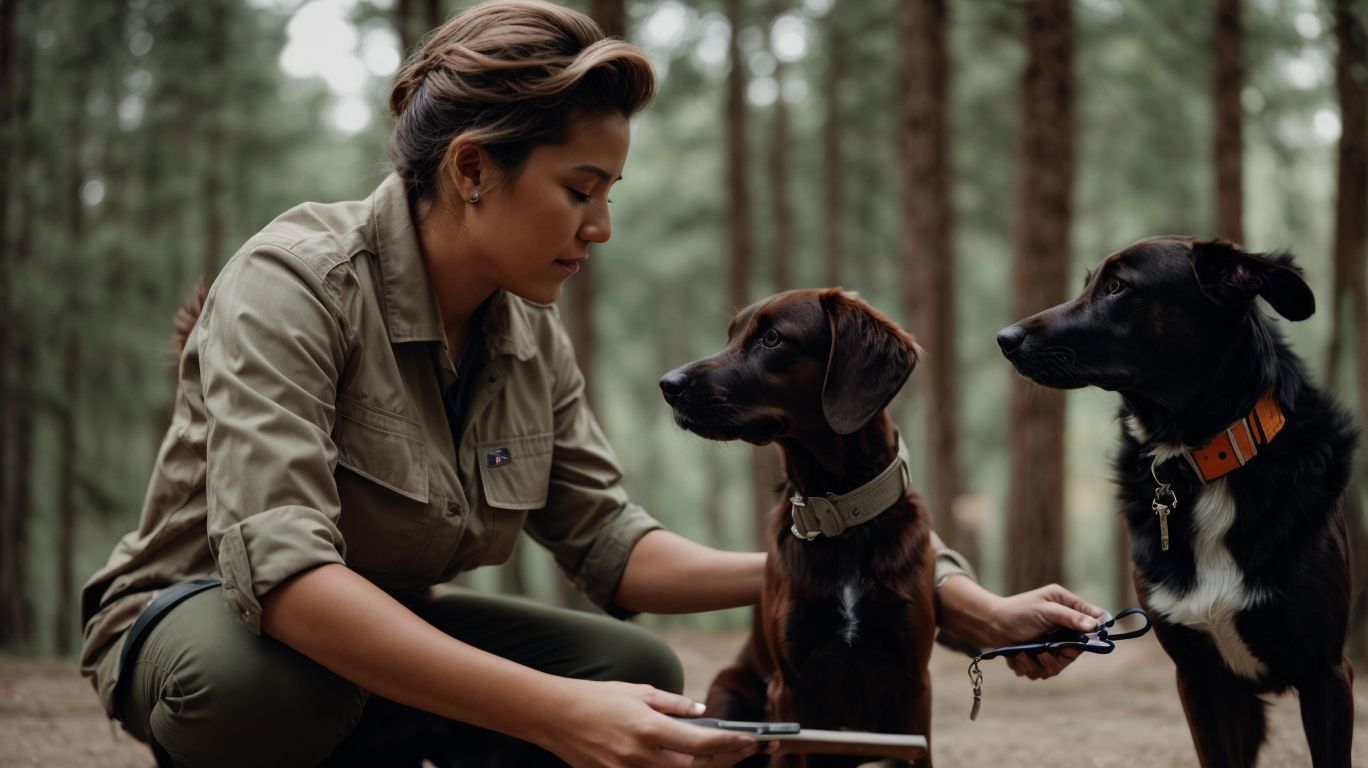
Maximizing Training Effectiveness: Advanced Techniques in Clicker Training for Dogs
Are you looking to enhance your dog’s training experience and strengthen your bond with your furry friend? Clicker training for dogs offers a positive and effective method for teaching new behaviors and reinforcing good habits. In this comprehensive guide, we will explore the principles and techniques of clicker training, as well as the benefits and potential pitfalls.
From understanding the basics of how clicker training works to mastering advanced techniques such as shaping behavior and target training, this article will equip you with the knowledge needed to maximize the effectiveness of your dog’s training. Whether you’re a seasoned trainer or just starting out, this guide will provide valuable insights into the world of clicker training for dogs.
What is Clicker Training for Dogs?
Clicker training for dogs is a positive reinforcement method that utilizes a small handheld device, known as a clicker, to mark desired behaviors and facilitate effective learning in dogs.
This approach relies on the principles of operant conditioning, enabling dogs to associate the clicking sound with a behavior that will result in a reward or positive outcome. By consistently reinforcing desirable actions with a click followed by a treat or praise, dogs quickly learn to repeat these behaviors.
Positive reinforcement plays a pivotal role in modifying dog behavior, creating a strong bond between the dog and the trainer while fostering a positive learning environment.
How Does Clicker Training Work?
Clicker training operates on the principles of operant conditioning, utilizing the click sound as a marker for desired behaviors, which are then reinforced with rewards to shape the dog’s behavior through systematic analysis and training tools.
This form of training focuses on positively reinforcing the dog’s actions, encouraging them to repeat behaviors that lead to rewards. By consistently pairing the click with a treat or praise, the dog learns to associate the sound with a positive outcome, strengthening the desired behavior.
Behavior analysis plays a crucial role in observing, understanding, and modifying the dog’s responses to various stimuli, allowing trainers to create effective training plans tailored to individual dogs. The clicker serves as a precise communication tool, providing instant feedback to the dog and enhancing the efficiency of operant conditioning.
What Are the Benefits of Clicker Training for Dogs?
Clicker training for dogs offers numerous benefits, including the effective application of positive reinforcement techniques, targeted behavior modification, and the facilitation of productive training sessions.
Positive Reinforcement
Positive reinforcement is a fundamental aspect of clicker training, utilizing a reinforcement schedule to condition desired behaviors through the consistent application of rewards, aligning with the principles of operant conditioning.
This method of training focuses on rewarding the behaviors that the trainer wants to see repeated, leading to the strengthening of those behaviors. By using a clicker as a signal for when the desired behavior occurs, followed by a reward, the dog learns to associate the click with the reward, making the clicker an effective communication tool.
The timing and consistency of the rewards play a crucial role in shaping the dog’s behavior, creating a positive learning experience and strengthening the bond between the trainer and the dog.
Clear Communication
Clicker training promotes clear communication between the trainer and the dog, fostering an understanding of desired behaviors through effective application of animal communication principles and behavior analysis.
This method allows for real-time feedback, enabling the dog to associate specific actions with positive reinforcement in a precise manner. By leveraging insights from animal communication, trainers can adapt their communication style to better align with the dog’s understanding, ultimately leading to more successful training outcomes.
Incorporating behavior analysis into the process aids in recognizing patterns and adjusting training strategies to suit the individual needs and learning pace of each dog, creating a harmonious environment for learning and development.”
Builds Trust and Bonding
Clicker training nurtures trust and bonding between dogs and their trainers, drawing from principles of animal psychology and behavior therapy to establish a strong and positive rapport during training sessions.
This approach emphasizes clear communication and rewards to reinforce desired behaviors, creating a harmonious and cooperative dynamic. By shaping the dog’s behavior through positive reinforcement, the trainer can cultivate a sense of mutual understanding and respect. Through this method, dogs feel empowered and eager to engage, fostering a deepened connection and enhancing the overall training experience.
What Are Some Advanced Techniques in Clicker Training for Dogs?
Advanced clicker training techniques encompass behavior shaping, stimulus control, and the application of positive training methods to refine and expand a dog’s behavioral repertoire through systematic conditioning and reinforcement.
Behavior shaping involves breaking down desired behaviors into smaller achievable steps, gradually shaping the dog’s actions towards the targeted behavior. Stimulus control focuses on teaching the dog to respond to specific cues while ignoring others, fostering precision in their responses.
Positive training methods emphasize rewarding desired behaviors, such as with treats or praise, to encourage the dog to repeat those actions. These nuanced techniques require patience, consistency, and a deep understanding of the dog’s individual learning style and motivations.
Shaping Behavior
Behavior shaping involves the strategic application of conditioning techniques and a systematic training approach to gradually mold and refine specific behaviors in dogs through the clicker training method.
This process starts with identifying the desired behavior and breaking it down into smaller, achievable steps. Each step is then reinforced with the use of a clicker, followed by a reward to create a positive association.
As the dog consistently performs the desired behavior, the criteria for reinforcement is gradually raised, shaping the behavior towards the desired outcome. Through this method, dogs learn to make associations between their actions and the clicking sound as they strive to receive a reward, leading to lasting behavioral changes.
Target Training
Target training in clicker training focuses on leveraging principles of animal learning to create a structured training program that directs a dog’s attention and actions towards specific targets, further enhancing the learning process.
By using a clicker as a marker for desired behavior, trainers can effectively communicate to the dog when they have performed the correct action. This positive reinforcement helps solidify the association between the behavior and the command, leading to faster and more reliable responses.
Through consistent and repetitive training sessions, dogs learn to understand and respond to the specific cues associated with different targets, enabling them to perform tasks with precision and agility.
Capturing Behavior
Capturing behavior in clicker training involves the astute application of behavior techniques and analysis to identify and reinforce spontaneous desirable behaviors exhibited by dogs, contributing to a comprehensive training approach.
This approach emphasizes the importance of recognizing and rewarding positive actions, allowing the dog to associate the sound of the clicker with the correct behavior. By capturing these moments, trainers can shape the dog’s behavior effectively and build a strong bond based on trust and communication.
It also allows for a deeper understanding of the dog’s responses and triggers, facilitating a tailored training program that addresses specific behavioral challenges.
How to Maximize Training Effectiveness with Clicker Training?
Maximizing training effectiveness in clicker training involves the consistent application of a reinforcement schedule, the strategic use of training tools, and a dedicated approach to obedience training to optimize the learning outcomes for dogs.
By implementing a reinforcement schedule that is tailored to the individual dog’s learning pace and needs, trainers can ensure that positive behaviors are consistently rewarded, leading to accelerated progress. The use of appropriate training tools, such as clickers, treats, and toys, can aid in reinforcing desired behaviors and shaping new ones.
The role of obedience training cannot be overstated, as it establishes a foundation of discipline and respect that underpins all other training efforts.
Consistency is Key
Consistency forms the cornerstone of effective clicker training, underpinning the principles of behavior modification and the application of diverse training methods to ensure a harmonized and productive learning experience for dogs.
By maintaining a consistent approach, pet owners can reinforce desired behaviors and effectively communicate with their dogs. It establishes a predictable environment, allowing for the reinforcement of positive actions and the correction of undesirable ones. Consistency in clicker training promotes clarity in cues and commands, which is essential for shaping desired behaviors.
Without this consistency, dogs may become confused and less responsive to training, hindering their overall progress.
Use High-Value Rewards
The strategic use of high-value rewards in clicker training aligns with the principles of positive reinforcement techniques, elevating the learning experience and reinforcing desirable dog behaviors effectively.
These rewards play a crucial role in shaping the dog’s behavior by providing a powerful incentive for them to repeat desired actions. By offering rewards that are highly valued by the dog, such as treats or praise, trainers can establish a strong positive association with the behavior being reinforced. This creates a motivating environment where dogs are eager to engage and learn.
High-value rewards contribute to building a deeper bond between the dog and the trainer, enhancing communication and trust throughout the training process.
Keep Training Sessions Short
Short and focused training sessions are essential in clicker training, integrating behavior shaping techniques and effective animal training methods to maximize the learning potential within each session.
For instance, shorter training sessions help maintain a high level of focus and attention from the animal, preventing fatigue or disinterest. By breaking down complex behaviors into smaller, achievable steps, trainers can effectively shape and reinforce desired actions, leading to quicker progress and improved retention.
Short sessions allow for frequent reinforcement, keeping the training experience positive and engaging for the animal, thus enhancing motivation and responsiveness in future sessions.
Be Patient and Positive
Patience and positivity are crucial elements in clicker training, drawing from the principles of positive training methods and insights from animal cognition to foster a supportive and conducive learning environment for dogs.
By maintaining a calm and patient demeanor, trainers can effectively communicate with their canine companions, enabling them to develop essential skills and behaviors. This approach not only focuses on rewarding desired actions but also highlights the importance of clear communication and mutual trust. Incorporating these elements enhances the bond between the trainer and the dog, ultimately leading to more successful and fulfilling training outcomes.
What Are Some Common Mistakes in Clicker Training for Dogs?
Several common mistakes can hinder the effectiveness of clicker training, including the misapplication of operant conditioning principles and shortcomings in executing comprehensive behavior modification strategies.
It’s crucial to understand that clicker training is not solely about reinforcing good behavior; it also involves identifying and addressing underlying behavioral issues. One mistake is over-reliance on the clicker as the main reinforcement rather than using it as a marker for desired behavior. Inconsistency in timing and delivery of rewards can confuse the animal, leading to erratic responses. It’s essential to combine clicker training with a robust behavior modification plan to address complex behaviors, ensuring a holistic approach to training.
Inconsistent Timing
Inconsistent timing in clicker training can impede the effectiveness of behavior shaping and stimulus control, disrupting the clarity and precision of communication between the trainer and the dog.
The timing of the clicker is crucial in reinforcing the desired behavior. When the timing is inconsistent, the dog may struggle to associate the click with the specific action, leading to confusion and hindering the learning process. This inconsistency can also impact stimulus control, making it challenging for the dog to differentiate between various cues and commands. As a result, the training progress may be hindered, and the dog’s response may become less predictable.
Using the Clicker as a Punishment
Misusing the clicker as a form of punishment contradicts the principles of conditioning techniques in clicker training, potentially leading to confusion and negative associations for the dog.
This can hinder the effectiveness of the training and compromise the trust between the dog and the trainer. Clicker training emphasizes positive reinforcement, where the click serves as a marker for desired behavior, followed by a reward. Introducing punishment through the clicker can disrupt the clarity of communication and diminish the dog’s motivation to perform desired behaviors.
It’s important to maintain consistency in using the clicker as a positive marker to reinforce good behavior, fostering a harmonious and effective training environment.”
Not Adjusting to the Dog’s Individual Needs
Neglecting to adjust to the individual needs of the dog can hinder the efficacy of clicker training, underscoring the importance of personalized behavior analysis and tailored training programs to accommodate diverse learning requirements.
This approach enables trainers to identify the specific triggers and motivators for each dog, allowing for a more comprehensive understanding of their behavior. By integrating insights from behavior analysis, trainers can develop customized training programs that address the unique needs and abilities of each dog, ultimately leading to more successful outcomes.
Incorporating relevant keywords for context and depth, such as positive reinforcement and shaping, further enhances the efficacy of the training process.
How to Troubleshoot Common Issues in Clicker Training?
Addressing common issues in clicker training requires a nuanced understanding of dog behavior and the application of effective behavior therapy to identify and rectify obstacles encountered during the training process.
When dealing with challenges in clicker training, it’s crucial to recognize that each dog is unique, and their behavior is influenced by a myriad of factors. One effective strategy involves observing the dog’s body language and reactions to identify any signs of stress or confusion. Incorporating positive reinforcement and maintaining a consistent routine can also significantly impact the training outcomes. By understanding the dog’s natural instincts and motivations, trainers can tailor their approach to address specific issues and create a more harmonious training experience.
Dog Not Responding to the Clicker
When a dog does not respond to the clicker, employing alternative training strategies and insights from animal learning becomes crucial to reestablish the communication and reinforce desired behaviors effectively.
One effective approach is to identify the specific reasons behind the lack of response. For instance, it could be due to distractions, fear, or lack of understanding. Tailoring the training to address these underlying issues can enhance the dog’s receptiveness to the clicker.
Incorporating positive reinforcement techniques, such as treats or praise, alongside the clicker can strengthen the association between the click and the desired behavior, making the training more effective and enjoyable for the dog.
Dog Becoming Distracted or Overexcited
Managing a distracted or overexcited dog in clicker training necessitates a tailored training approach that addresses the specific triggers and employs effective methods to regain the dog’s focus and composure during training sessions.
By understanding the individual temperament and behavior of your furry companion, you can implement targeted strategies that resonate with their unique needs. Encouraging a calm and attentive demeanor, incorporating short and engaging training intervals, and utilizing positive reinforcement techniques can play a pivotal role in redirecting their attention and fostering a conducive learning environment.
Incorporating physical and mental enrichment activities also helps in channeling excess energy and enhancing their ability to remain focused during training.
Dog Not Generalizing Behaviors
Addressing challenges related to the dog not generalizing behaviors in clicker training entails the refinement of stimulus control and the application of effective animal training techniques to facilitate the seamless transfer of learned behaviors across diverse contexts.
Consistency in cues and environmental settings is crucial for helping the dog to generalize learned behaviors. By gradually introducing new environments and distractions during training sessions, the dog can learn to respond reliably to commands regardless of the circumstances. Breaking down complex behaviors into smaller components and reinforcing each step can aid in the generalization process.
It’s essential to emphasize clarity in communication and reinforce desired behaviors consistently across various situations to promote successful generalization in clicker training.




No Comments